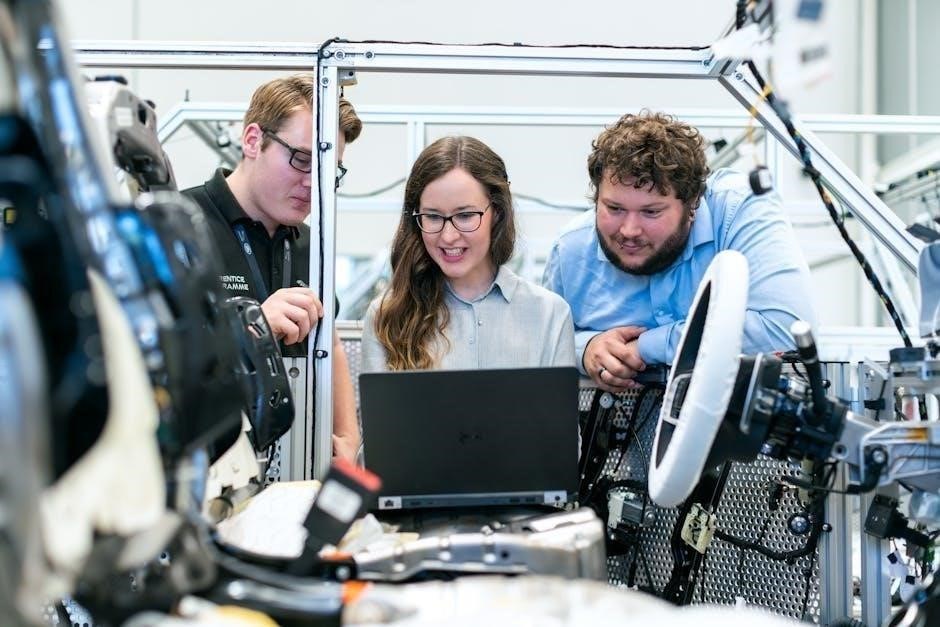The Living Environment Regents Exam is a comprehensive assessment of high school students’ understanding of biological and environmental concepts. It evaluates knowledge of ecosystems‚ genetics‚ evolution‚ and human body systems‚ preparing students for advanced scientific studies and fostering critical thinking skills essential for addressing real-world environmental challenges.
1.1 Overview of the Exam Format
The Living Environment Regents Exam consists of multiple-choice questions and open-response questions‚ assessing students’ understanding of core biological concepts. The exam is divided into several sections‚ with a total of approximately 75 questions. The majority are multiple-choice‚ while the remainder require written responses. Questions are designed to evaluate critical thinking‚ analysis‚ and the ability to apply scientific principles to real-world scenarios. The exam also includes laboratory-based questions and case studies to test practical skills. Students are provided with a reference table of important biological concepts and formulas to aid in answering certain questions. The exam is scored out of 85 points‚ with a passing score of 65. The format is designed to ensure a comprehensive evaluation of knowledge and skills acquired throughout the course‚ preparing students for future scientific endeavors and informed decision-making about environmental and health issues.
1.2 Importance of the Exam in High School Curriculum
The Living Environment Regents Exam plays a pivotal role in the high school curriculum‚ serving as a cornerstone for scientific literacy and critical thinking. It ensures students gain a foundational understanding of biology and environmental science‚ essential for addressing global challenges. The exam aligns with state education standards‚ fostering skills in analysis‚ problem-solving‚ and application of scientific principles. It prepares students for advanced courses in science‚ technology‚ engineering‚ and mathematics (STEM) fields. Additionally‚ the exam emphasizes the importance of environmental stewardship‚ equipping students with knowledge to make informed decisions about sustainability and conservation. By mastering the content‚ students are better prepared to engage with real-world issues‚ making the exam a vital component of their educational journey. Its significance extends beyond academia‚ impacting students’ ability to contribute positively to society and the environment.

Cell Structure and Function

This section explores the fundamental biology of cells‚ including their structure‚ functions‚ and importance in biological processes. Understanding cells is crucial for grasping life’s basic mechanisms and systems.
2.1 Cell Membrane and Transport Mechanisms
The cell membrane‚ a semi-permeable phospholipid bilayer‚ regulates the movement of materials in and out of the cell. It consists of a double layer of phospholipids with embedded proteins that facilitate transport and communication. Transport mechanisms include passive transport (e.g.‚ diffusion‚ osmosis) and active transport‚ which requires energy. Diffusion involves substances moving from high to low concentration‚ while osmosis specifically refers to water movement. Active transport uses carrier proteins to move substances against their concentration gradient‚ often requiring ATP. Additionally‚ endocytosis and exocytosis allow for the transport of larger molecules. Understanding these mechanisms is essential for comprehending how cells maintain homeostasis and interact with their environment. These processes are critical for cellular function and survival‚ making them a key focus in the Living Environment Regents Exam.
2.2 Key Cell Organelles and Their Functions
Cells contain various organelles‚ each with specific roles essential for cellular function. The nucleus acts as the control center‚ housing DNA and regulating gene expression. Mitochondria‚ known as the powerhouses‚ produce ATP through cellular respiration. Ribosomes synthesize proteins‚ crucial for growth and repair. The endoplasmic reticulum (ER) modifies proteins; the rough ER has ribosomes‚ while the smooth ER handles lipid synthesis and detoxification. The Golgi apparatus further processes and distributes proteins. Lysosomes contain digestive enzymes‚ breaking down waste and cellular debris. Chloroplasts‚ found in plant cells‚ perform photosynthesis‚ converting light energy into chemical energy. Understanding these organelles and their specialized functions is vital for grasping cellular biology concepts‚ especially as they relate to metabolism‚ transport‚ and overall cell maintenance‚ making them a key focus area for the Living Environment Regents Exam.
2.3 Photosynthesis Process and Importance
Photosynthesis is a vital biological process where plants‚ algae‚ and some bacteria convert light energy into chemical energy. It occurs in chloroplasts and involves two main stages: the light-dependent reactions and the Calvin cycle. Light-dependent reactions capture energy from sunlight‚ producing ATP and NADPH. The Calvin cycle uses these energy-rich molecules to fix carbon dioxide into glucose‚ releasing oxygen as a byproduct. Photosynthesis is essential for life on Earth‚ providing the oxygen humans and animals need to breathe while serving as the primary source of energy for food chains. It also reduces carbon dioxide levels‚ mitigating the greenhouse effect. Understanding photosynthesis is critical for the Living Environment Regents Exam‚ as it underpins ecological balance‚ agricultural productivity‚ and Earth’s climate regulation.

Genetics and DNA
Genetics and DNA are fundamental to understanding heredity‚ variation‚ and life processes. DNA replication ensures genetic continuity‚ while modern techniques like CRISPR revolutionize genetic engineering and biotechnology applications.
3.1 DNA Structure and Replication
DNA (deoxyribonucleic acid) is a double-stranded helix with sugar-phosphate backbones and nitrogenous bases projecting inward. Adenine pairs with thymine‚ and cytosine pairs with guanine through hydrogen bonding. DNA replication is semi-conservative‚ meaning each new molecule contains one original strand and one newly synthesized strand. Helicase unwinds the double helix‚ and DNA polymerase synthesizes complementary strands. This process ensures genetic continuity and accuracy across generations.
Understanding DNA structure and replication is crucial for grasping genetic inheritance‚ mutations‚ and biotechnological applications. Errors in replication can lead to mutations‚ potentially affecting gene function. This section emphasizes the molecular mechanisms underlying life’s continuity‚ preparing students for advanced topics in genetics and biotechnology.
3.2 Mendelian Genetics and Inheritance Patterns
Mendelian genetics focuses on the inheritance patterns of traits controlled by single genes‚ as discovered by Gregor Mendel. Key principles include the Law of Segregation‚ where alleles separate during gamete formation‚ and the Law of Independent Assortment‚ where different genes segregate independently. These laws explain how dominant and recessive alleles interact to produce specific phenotypes. Students analyze monohybrid and dihybrid crosses to predict offspring ratios‚ using Punnett squares as visual tools. Understanding genotype-to-phenotype relationships is crucial for interpreting inheritance patterns. Mendel’s work lays the foundation for modern genetics‚ enabling predictions of trait transmission in organisms‚ including humans. This section emphasizes the importance of alleles‚ their combinations‚ and how genetic variation arises in populations‚ preparing students to apply these concepts to real-world scenarios and genetic disorders.
3.3 Modern Genetics Techniques
Modern genetics techniques have revolutionized the field of biology‚ enabling precise manipulation and analysis of genetic material. Key techniques include DNA sequencing‚ polymerase chain reaction (PCR)‚ and CRISPR gene editing. DNA sequencing identifies the exact order of nucleotides in a DNA molecule‚ crucial for understanding genetic codes and diagnosing disorders. PCR amplifies specific DNA segments‚ allowing researchers to study genes in detail. CRISPR enables targeted gene editing‚ offering potential solutions for genetic diseases and agricultural improvements. Additionally‚ gel electrophoresis separates DNA fragments by size‚ aiding in genetic analysis and identification. These tools have transformed fields like medicine‚ agriculture‚ and biotechnology. Understanding these techniques is essential for solving complex genetic problems and advancing scientific research.
Evolution and Natural Selection
Evolution and natural selection drive biodiversity‚ shaping species over time through environmental pressures. Mechanisms like mutation‚ genetic drift‚ and gene flow contribute to evolutionary change‚ supported by fossil records and comparative genetics;
4.1 Mechanisms Driving Evolutionary Change
Evolutionary change is driven by several key mechanisms that shape biodiversity over time. Natural selection‚ a fundamental process‚ favors individuals with traits that enhance survival and reproduction in specific environments. Mutation introduces genetic variation‚ providing raw material for evolution. Genetic drift‚ often due to random events‚ alters allele frequencies in populations. Gene flow‚ the movement of genes between populations‚ can increase genetic diversity or lead to homogenization. These mechanisms collectively drive adaptation and speciation‚ ensuring species’ survival in dynamic ecosystems. Understanding these processes is crucial for grasping how life on Earth has diversified and continues to evolve in response to environmental challenges.
4.2 Evidence Supporting Evolutionary Theory
The theory of evolution is supported by multiple lines of evidence from various scientific fields. Comparative anatomy reveals similarities in bone structures across different species‚ suggesting a common ancestry. For example‚ the forelimbs of vertebrates‚ such as birds‚ whales‚ and humans‚ share similar bone structures despite their different functions. Embryology shows that embryos of different species often exhibit similar traits early in development‚ like gill slits in humans and fish‚ which disappear as they mature. Molecular biology provides evidence through DNA and protein sequence comparisons‚ indicating evolutionary relationships. The fossil record documents the chronological appearance of life forms‚ with transitional fossils bridging gaps between species. Additionally‚ natural selection has been observed in action‚ such as antibiotic resistance in bacteria and the adaptation of the peppered moth. These diverse evidence types collectively confirm the validity of evolutionary theory.

Ecology and Ecosystems
Ecology studies interactions between organisms and their environment‚ focusing on energy flow‚ nutrient cycling‚ and biodiversity. Ecosystems include producers‚ consumers‚ and decomposers‚ with humans impacting these systems through pollution and resource depletion.
5.1 Structure and Components of Ecosystems
An ecosystem is a complex network of living organisms (biotic components) and non-living elements (abiotic components) interacting in a specific environment. Biotic components include producers (plants‚ algae)‚ consumers (herbivores‚ carnivores)‚ and decomposers (fungi‚ bacteria). Abiotic factors such as light‚ temperature‚ water‚ and nutrients play a critical role in sustaining life. Ecosystems are organized hierarchically‚ from individual organisms to populations‚ communities‚ and the ecosystem itself. The structure of an ecosystem determines how energy flows and nutrients cycle through it. Producers form the base of the food web‚ converting solar energy into organic matter. Consumers rely on producers for energy‚ while decomposers recycle nutrients back into the environment. Understanding the structure and components of ecosystems is essential for analyzing how they function and respond to environmental changes‚ such as pollution or climate shifts. This knowledge is vital for addressing ecological challenges and promoting sustainability.
5.2 Energy Flow and Nutrient Cycles
Energy flow in ecosystems follows a unidirectional path‚ beginning with producers like plants that capture sunlight through photosynthesis. This energy is transferred to herbivores‚ then to carnivores‚ and eventually to decomposers. The Law of Conservation of Energy dictates that only 10% of energy is passed to the next trophic level‚ while the rest is lost as heat or used for metabolic processes. Nutrient cycles‚ such as carbon‚ nitrogen‚ and phosphorus cycles‚ ensure the reuse of essential elements within ecosystems. Decomposition plays a key role in returning nutrients to the soil‚ where they can be absorbed by producers. These cycles are vital for sustaining life‚ as they maintain the availability of resources necessary for growth and survival. Understanding energy flow and nutrient cycling is crucial for analyzing ecosystem health and the impact of human activities on environmental balance.
5.3 Human Impact on Environmental Systems
Human activities significantly influence environmental systems‚ often leading to habitat destruction‚ pollution‚ and climate change. Deforestation‚ urbanization‚ and industrial practices disrupt ecosystems‚ reducing biodiversity and altering nutrient cycles. Pollution from fossil fuels‚ plastics‚ and agricultural runoff contaminates air‚ water‚ and soil‚ affecting both wildlife and human health. Climate change‚ driven by greenhouse gas emissions‚ disrupts energy flow and nutrient cycles‚ causing extreme weather events and shifting species distributions. Conservation efforts‚ sustainable practices‚ and policy changes are essential to mitigate these impacts. Students studying for the Living Environment Regents Exam should understand these human-induced changes and their long-term consequences on environmental systems‚ as well as strategies for promoting environmental stewardship and sustainable development. Addressing these challenges requires a comprehensive approach to protect ecosystems and ensure a balanced relationship between human activities and natural systems.

Human Body Systems
The human body is composed of interconnected systems like the nervous‚ circulatory‚ respiratory‚ digestive‚ and excretory systems‚ each playing a vital role in maintaining overall health and homeostasis.
6.1 Nervous and Muscular Systems
The nervous and muscular systems are essential for controlling and coordinating body functions. The nervous system‚ comprising the central (brain and spinal cord) and peripheral nervous systems‚ enables communication through neurons and neurotransmitters. The muscular system‚ including skeletal‚ smooth‚ and cardiac muscles‚ works with the nervous system to facilitate movement and maintain posture. Key concepts include reflexes‚ muscle contraction mechanisms (like sliding filament theory)‚ and the role of motor neurons. Understanding these systems is crucial for grasping how the body responds to stimuli and maintains homeostasis. Students should focus on how these systems interact and their significance in overall bodily functions.
6.2 Circulatory and Respiratory Systems
The circulatory and respiratory systems are vital for delivering oxygen and nutrients to cells while removing waste products. The circulatory system‚ including the heart‚ arteries‚ veins‚ and capillaries‚ transports blood throughout the body. The respiratory system‚ comprising the lungs‚ trachea‚ and bronchi‚ facilitates gas exchange through breathing. Key processes include oxygen diffusion into the bloodstream via alveoli and carbon dioxide removal. The circulatory system relies on the heart’s pumping action‚ while the respiratory system depends on diaphragm contractions for inhalation and exhalation. These systems work together to maintain homeostasis‚ ensuring cells receive oxygen and nutrients for metabolic processes. Understanding their interconnected functions is crucial for grasping how the body sustains life and responds to physical demands. Students should focus on mechanisms like gas exchange‚ blood pressure regulation‚ and the role of hemoglobin in oxygen transport.
6.3 Digestive and Excretory Systems
The digestive and excretory systems are essential for nutrient absorption‚ waste elimination‚ and maintaining overall bodily functions. The digestive system processes food through ingestion‚ mechanical digestion in the mouth and stomach‚ and chemical digestion via enzymes in the small intestine‚ where nutrients are absorbed into the bloodstream. The excretory system‚ including the kidneys‚ filters waste from the blood‚ producing urine‚ while the liver detoxifies harmful substances. The large intestine absorbs water and eliminates solid waste as feces. Both systems work together to ensure proper nutrient utilization and waste removal‚ maintaining homeostasis. Understanding their functions‚ including enzyme roles and kidney filtration‚ is key for comprehending human physiology and health. This knowledge is vital for addressing issues like digestive disorders and renal failures‚ emphasizing the importance of these systems in sustaining life and overall well-being.

Exam Preparation Strategies
Effective preparation involves active learning‚ consistent review‚ and practice exams. Focus on understanding key concepts‚ organizing study materials‚ and mastering test-taking techniques to build confidence and achieve success.
7.1 Effective Study Techniques
Effective study techniques are crucial for success on the Living Environment Regents Exam. Start by breaking down complex topics into manageable sections‚ focusing on key concepts like cell structures‚ genetics‚ and ecosystems. Utilize active learning methods such as creating detailed flashcards‚ concept maps‚ and self-quizzes to reinforce memory retention. Regular review sessions‚ even short ones‚ help maintain a strong grasp of the material. Incorporate practice exams to simulate test conditions‚ allowing you to identify and address weaknesses. Additionally‚ teach the material to someone else or explain it aloud‚ which reinforces understanding. Prioritize difficult areas and seek clarification from teachers or resources when needed. Staying organized‚ maintaining a study schedule‚ and ensuring adequate rest and nutrition are also vital for optimal performance.
7.2 Utilizing Practice Exams
Practice exams are a cornerstone of effective preparation for the Living Environment Regents Exam. They provide students with a realistic simulation of test conditions‚ helping them become familiar with the format‚ timing‚ and types of questions. Regularly taking practice exams allows students to identify areas of weakness‚ focus their study efforts‚ and track progress over time. After completing a practice exam‚ review the answers thoroughly‚ paying special attention to incorrect responses to understand and correct misconceptions. This process reinforces learning and builds confidence. Additionally‚ practice exams help students develop essential time management skills‚ ensuring they can complete the test within the allotted time. By consistently utilizing practice exams‚ students can refine their test-taking strategies and approach the actual exam with greater confidence and readiness.

Common Exam Questions and Mistakes
Students preparing for the Living Environment Regents Exam often encounter similar challenging questions and make recurring mistakes. One common error is misinterpreting the nuances of ecological concepts‚ such as the difference between a habitat and a niche. Another frequent mistake involves confusing photosynthesis and cellular respiration‚ particularly in identifying reactants‚ products‚ and the locations where these processes occur. Many students also struggle with genetics problems‚ especially Punnett squares and probability calculations. Additionally‚ time management issues often lead to incomplete answers or skipped questions. A significant number of students misunderstand the concept of natural selection versus genetic drift‚ which are both mechanisms of evolution but operate differently. To avoid these pitfalls‚ it is crucial to thoroughly review these topics‚ practice applying concepts to real-world scenarios‚ and seek clarification on confusing material. Addressing these common mistakes early in the study process can significantly improve exam performance.

Test-Taking Strategies
Effective test-taking strategies are essential for success on the Living Environment Regents Exam. Start by carefully reading each question and identifying key terms to understand what is being asked. Allocate time wisely‚ spending no more than one minute per multiple-choice question and three minutes per open-response question. Answer easier questions first to build confidence and maximize points before tackling more challenging ones. Use the process of elimination to narrow down choices when unsure of the correct answer. For open-response questions‚ outline your thoughts briefly before writing to ensure clarity and organization. Manage stress by taking deep breaths and staying focused. Review your answers if time permits‚ but avoid second-guessing yourself unnecessarily. These strategies will help you approach the exam systematically‚ ensuring you perform to the best of your ability and achieve a strong score.

Additional Resources for Success
To excel on the Living Environment Regents Exam‚ utilize additional resources to reinforce your understanding. Online platforms like Khan Academy and YouTube offer video tutorials and explanations for key biology concepts. Practice exams from the New York State Education Department (NYSED) and study guides like Barron’s Living Environment provide realistic test simulations. Join study groups or online forums to discuss challenging topics with peers. Educational apps such as Quizlet and Kahoot! can help you memorize terms and concepts through interactive flashcards and games. Additionally‚ many teachers and educators share study materials on platforms like Google Classroom or Schoology. Leveraging these resources alongside your textbook and class notes will ensure a well-rounded preparation strategy. Remember‚ consistent review and active engagement with study materials are crucial for achieving success on the exam.



